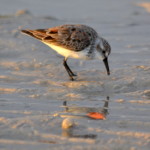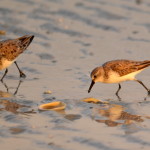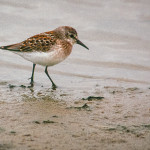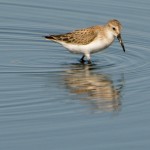March Bird of the Month is Western Sandpiper, and here is the article in March Kite written by Ben Kolstad
Western Sandpiper (Calidris mauri) is ASE’s March bird of the month, the first of three regularly occurring “peeps” in our area that we’ll be reviewing (out of five total in North America). This group of small sandpipers got their names, not from a corruption of the name “sandpiper” but because of their high-pitched “peep” calls (although one could argue that the origin of the name sandpiper itself comes from their high piping call). Whatever the origin of the name, two peeps in particular are notoriously difficult to differentiate, although in the last several decades some reasonable characteristics have emerged. Nevertheless, Western Sandpiper is so similar to its congener, the Semipalmated Sandpiper (C. pusilla), that it had been systematically misidentified in the ornithological literature for over 100 years! (Allan Phillips’s 1975 article in American Birds finally clinched the case.)
Western Sandpiper has black legs and feet and a short, slightly downcurved bill. Peterson calls it “perhaps the palest peep,” with its unmarked whitish underparts contrasting with its gray or gray-brown upperparts (in breeding plumage, which we rarely see, it’s quite a bit redder above). That, combined with its “wider, puffier head and bulkier chest and neck” (Karlson & Rosselet, Peterson Reference Guide to Birding by Impression) might be of help in separating this winter resident of our shores from its scarcer migrant cousin (more on this in May, migration season). In our area, it can be found on mudflats, sandflats, estuaries, lakeshores, and, during migration, in the flooded agricultural fields inland.
Quick quiz: which bird is more common in Florida, western or semipalmated? Answer: at least in winter, if you think you’ve seen a Semipalmated Sandpiper anywhere north of Florida Bay, it’s headline news.
Come to our March 1 meeting to hear more about this bird.
(Photographer’s please note that next month’s April 2016 Bird will be the Least Sandpiper)
- Western Sandpipers taken near sunset on Bunche Beach near Fort Myers, FL. by Susan McKemy The distinguishing characteristics of the Western Sandpiper visible in these photos: Rufous (reddish-brown) cap and “cheek patch”, Dark bill with decurved tip. . Black legs and feet.
- Western Sandpipers taken near sunset on Bunche Beach near Fort Myers, FL. by Susan McKemy The distinguishing characteristics of the Western Sandpiper visible in these photos: Rufous (reddish-brown) cap and “cheek patch”, Dark bill with decurved tip. . Black legs and feet.
- Western Sandpiper by Paul Thomas: juvenile at breeding grounds in Nome Alaska
- western sandpiper at Duda Farms ASE birding trip by Suzanne Zuckerman





Comments are closed